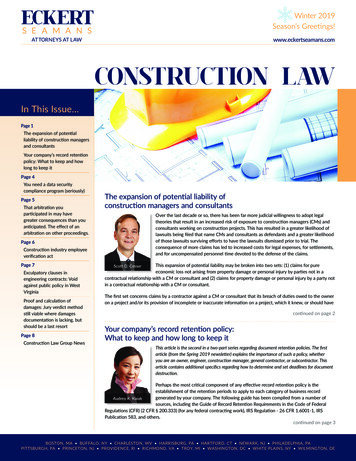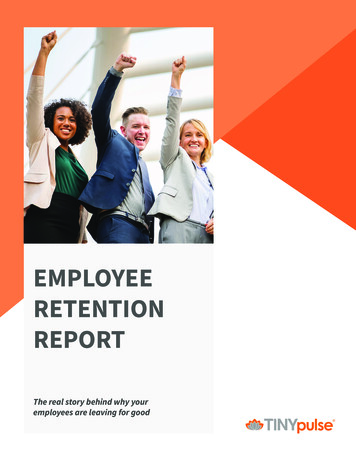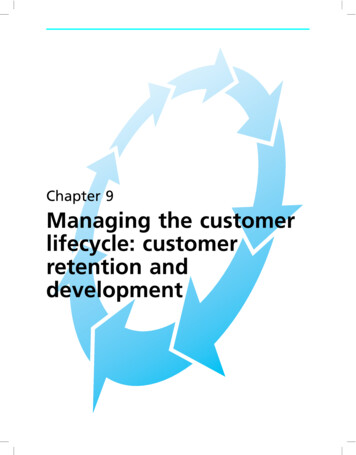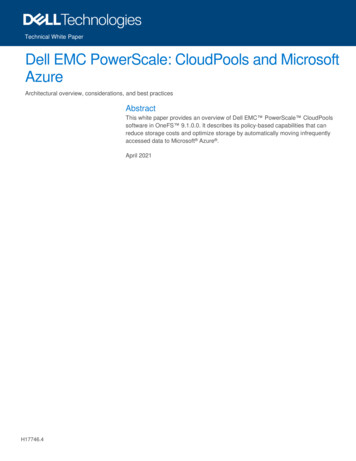
Transcription
RETENTION:IS IT GETTINGENOUGHATTENTION?
IntroductionSimon LanceRegional Director of Hays in ChinaThen there is the issue of company knowledge which can belost when an employee decides to leave. With them goes notonly valuable industry knowledge which can contribute to yourbusinesses’ future success, but knowledge about your company,your customers, current projects and past history, which cansometimes fall into the hands of your competitors. Often muchtime and money has been spent on the employee in expectationof a future return. Therefore, when the employee leaves, theinvestment is not realised.Customer and client relations can also be affected by staffturnover and the effect can be felt throughout an entireorganisation. Often co-workers are needed to pick up the extrawork left by those who have decided to leave and negativity canfilter through the remaining staff.So, here are just a few reasons to turn your attention to theissue of retention. We know China has high turnover rates, so werecently surveyed more than 900 candidates and clients in theHays Retention Survey in order to share with you their insights andthoughts on this vital topic.Retaining your top talent and curbing the turnover of staff canmean many things for a business.Firstly, it can reduce the cost of recruiting new candidates. Asmost hiring managers know, the cost of turnover adds significantlyto a company’s expenses. While it is difficult to fully calculate thecost of turnover it can often equate to 25 per cent of the averageemployee salary – and this is a conservative estimate.2 Retention: Is it getting enough attention?As we expect this trend to continue in the job market we hope thisreport will not only provide the full results of our survey but alsogive employers and candidates some valuable information andadvice they can use in the future.
Turning aroundthe turnoverTurnover is a real problem for employers in China and somethingthat affects business productivity. And it’s clear that China hasretention issues when you look at the rate of staff turnover. A Haysweb poll conducted at the end of 2012 highlighted candidatemovement, particularly around the one to two–year mark ofemployment. Of the more than 400 candidates surveyed, the webpoll showed that 41 per cent change jobs as often as every one totwo years, while 39 per cent change every two to four years. Only20 per cent stay with an employer for five years or more.In other research conducted during November 2012, the HaysRetention Survey asked more than 200 candidates how longthey remained in their previous role. More than a third or 35 percent left their employer after two to four years, while 14.5 percent decided to change jobs up to two years with their previousemployer. 10.4 per cent indicated they only stayed in their job forup to a year. It was promising, however, to see that 40.1 per cent ofcandidates stayed with their employer for more than four years.The next most important factor in a candidate’s decision to leave aposition is the need to seek new challenges (22.3 per cent). This isan indicator that perhaps these candidates feel their jobs are at a“dead end” with nowhere to progress, or they felt stale or bored. If ajob is inherently unfulfilling, it is likely employees will look elsewherefor other opportunities, no matter what incentives are in place,according to international research on the topic1.The third most popular response when candidates where asked whythey looked for a new job was salary, with only 13 per cent citingmoney as their motivation to leave an employer. Other factors thatcome into play when candidates are weighing up their optionswhether to stay or go include, poor management, lack of trainingand development, as well as office politics.Why are you looking for a new job? (tick most relevant)35On average, how long have you remained in your previous role?3025Up to one yearUp to two yearsTwo to four years2015105Over four years0Lack of careerprogressionSeeking a newchallengeHays believes there are several reasons behind this turnover trend.Over the last 20 years China has had a good macro economy,attracting many multinational corporations and other investors. Thishas in turn resulted in high demand for talent in the job market andit’s been more obvious in the tier-one cities. But it is now starting tohave an impact on tier-two and three cities.As a result, candidates are looking for – and finding – moreopportunities in the job market, therefore contributing to thehigh turnover rate. Interestingly our last Quarterly Report for 2012found that some candidates are placing job security above careerdevelopment or compensation when they look for their next role.A candidate perspectiveAs the saying goes, “people join a company and leave a boss”. Haysresearch shows lack of career progression topped the reasons whycandidates are prompted to find a new job, with 34.9 per cent ofrespondents to a Hays survey indicating this was their main impetusfor looking elsewhere for work.SalaryLack of trainingor developmentopportunitiesPoor managementToo much stressTravel time too greatSeeking to specialisein a particular fieldPoor work/life balanceOffice politicsThe provision of a clear career path (56.1 per cent), recognitionfor a job well done (48.6 per cent) and salary/benefits (47 percent) were the top three things candidates rated as ‘extremelyimportant’ factors to keeping them in their job. Being offered newresponsibilities/challenges (49.7 per cent) along with a level ofcontribution in decision making (49 per cent), strong management(46.6 per cent) and the company’s financial health and stabilityare also considered ‘very important’ to candidates. Flexibleworking options and the availability of mentorships are ‘somewhatimportant’, according to the candidates that responded to the HaysRetention esearch/2012/10/retentionreview-2012/1 Retention: Is it getting enough attention? 3
How important are the following factors in keeping you in a job?1Not important2Somewhatimportant3Important4Very importantDo you believe your current talent pool contains the skills yourbusiness needs for the future?5ExtremelyimportantChallenging workloadThe provision of a clear pathYesOngoing training & developmentNoMentorshipBeing offered new responsibilities/challengesThe company’s financial health and stabilityYour ‘fit’ with the company’s vision, culture & valuesDo you have a retention strategy in place?Recognition for a job well doneFormal performance feedbackMy job titleSalaryYesStrong managementNoWork/life balanceFlexible working optionsYour level of contribution to decision making20406080100What the employers sayDoes staff turnover have a negative impact on your business?Companies that experience a high rate of employee churn are oftenblind to the cause of staff malaise and the factors within the employer’scontrol – the job itself, pay and conditions and work relationships –account for 80 per cent of the reasons why staff choose to leave theirjobs. Most employers underestimate the importance of job satisfactionand flexibility to high performers in particular2.According to the Hays Retention Survey, almost half of employersrecognise that their current talent pool contains the skills theirbusiness needs for the future, yet more than a third or 37.8 percent do not have a retention strategy in place. The majority (88.6per cent) also know that staff turnover impacts negatively on theirbusiness. Meanwhile, 54.9 per cent of employers also admit they donot have a succession plan in search/2012/10/retentionreview-2012/2 4 Retention: Is it getting enough attention?YesNo
Does your organisation have a strategy in place for successionplanning?YesNoOf the 62.2 per cent of employers that said they have a retentionstrategy in place, 90.1 per cent say training and development formsa part of their plan. 78.7 per cent also recognise employees for a jobwell done, while 72.8 per cent give formal performance feedbackand appraisals. 67.3 per cent include regular salary reviews in theirretention strategy and 65.3 per cent of employers also providednew challenges.What strategies form part of your retention plan? (tick all relevant)100806040200Training &developmentMentorshipProvision ofchallengesEmployee opinion surveyOffering staff aclear career pathFormal performancefeedback & appraisalsRecognition for ajob well doneFlexible working optionsWork/life balance initiativesRegular salary reviewsCompetitive benefitsRetention: Is it getting enough attention? 5
strategies & solutionsSo, now that we have shown you the main findings of our HaysRetention Survey, let’s now turn to what you can do to ensure youretain your top talent.If yes, do you think this gives you an advantage when it comes tostaff retention and loyalty?At Hays we believe that retention doesn’t just become importantwhen a new employee walks in the door, but an employer shouldstart thinking about retention while they are attracting candidates– and this comes down to having a strong employee valueproposition (“EVP”) and employer branding.Prospective candidatesYesUnsureAn EVP – or Employee Value Proposition – is critical to youremployment branding. In essence, an EVP communicatesa company’s values and culture, as well as the rewards,opportunities and experience of working for your company.In short, an EVP communicates what it’s really like to work foryour company. The ultimate aim of crafting your EVP is to attractthe right type of candidate that shares your company’s values andis attracted to the communicated essence of what your companystands for. By communicating what you stand for and theexperience of working at your company, you’ll attract like-mindedcandidates who are a natural fit with your company and the wayyou do business. In our survey for example, we saw that culturalfit was vital to candidates with 36.7 per cent indicating this wasan ‘extremely important’ factor for them when it comes to stayingwith a company.So, once you research and identify your company’s unique EVP,you need to then put it in place, both internally and externally. Itwas positive to see in our survey that 82.7 per cent of employersfeel they have defined their business culture and look forcandidates that are a cultural match. Meanwhile, 73 per centrecognise that this gives them an advantage when it to comes tostaff retention and loyalty.Have you defined your business culture and do you recruitpeople who are a cultural match?NoBe consistentUltimately, the communication of your EVP will depend onmanagement, your marketing team and your HR department.But keep in mind that all communication needs to be consistent.This means not just during the recruitment process, but duringevery interaction your business makes – from advertising,customer service and office environment, to staff development,staff benefits, new products, telephone manner, emails and socialmedia. All elements of your business need to reflect and reinforceyour core values and EVP.For example, if in your EVP you claim to support work/life balanceor ongoing development, but do not provide ongoing training,study leave or flexible rosters, the reality of your workplace doesnot match your promised values, and new recruits will not havethe correct impression of what it is like to work for your company,which will result in higher turnover.So an EVP is more than just decorative sentences. It needs to be basedin truth, and should represent the sum of the working experience atyour company so you attract candidates that will be the right ‘fit’.Candidate attractionYesNoTo communicate your EVP during the attraction process you needto do more than just include it in job vacancy advertising, thecareers pages of your website and mentioning it to your recruiter– although these are important too! To avoid mixed messages,your EVP also needs to be communicated across all of yourtouch points, including your communication messages, website,customer service and all contacts with the company.This is because candidates will research your organisation – someextensively – before formally applying for the vacancy, and theywill also rely on the advice of others and your reputation in themarket, which is built up over time. They will not solely consideryour advertisement and the careers page on your website.So work with your HR and marketing teams to correlate allcommunications in line with your EVP and remember that eachcommunication is an opportunity to potentially reach out to newrecruits about your organisation and what it’s like to work for.6 Retention: Is it getting enough attention?
Recruitment processAn EVP also needs to be communicated – and seen in action –during the recruitment process. An EVP is not just a tool to attractcandidates. Your recruitment process needs to correlate with yourcommunicated EVP – and you need to deliver what was promisedduring the attraction process.This is because the expectations of what a company is like to workfor are largely formed during the recruitment process. Certainly,a candidate will apply for certain roles over others based on theirinitial perceptions and research, but for the most part they formmore solid expectations of what it would be like to work thereduring face-to-face interviews and interactions with the hiring anddirect managers.Imagine that a potential employee attends your office for aninterview, and in their brief interaction with staff receive aperception of working for the company that conflicts with thecommunicated EVP. If the receptionist is abrupt or computerequipment is old, but the company communicates itself ascutting-edge and welcoming, there is obvious disparity.While this is perhaps an extreme example, it shows why it isessential for your existing employees to understand your EVPas much as potential employees and align themselves withthe company’s vision and values. We cannot emphasise howimportant this is.It’s also why your EVP should not be built for recruitmentpurposes alone. Instead it needs to emulate exactly what yourbusiness is about on a daily basis in order to retain your staff. Soensure your EVP honestly reflects your company.New employeesA well-considered onboarding and induction program can alsohelp retain the employees you work hard to recruit.Often the terms onboarding and induction are usedinterchangeably, when the two, just as important as the other,are quite different. They are both, however, integral to helpingnew employees at every level contribute effectively as soon aspracticable and can influence them to stay on with an employer.The Hays Retention Survey showed employers are aware of howcrucial the first few months of employment are and 59.3 percent said it takes a new employer up to six months to perform attheir peak. So every step that can be taken to ensure a smoothtransition and in turn retain that staff member is vital.How long does it take to get a new employee performing at theirpeak?One monthDuring the interview, you can elaborate on the core messagesdelivered by your EVP. For example, you can share client oremployee testimonials about the working environment, companyvalues, products and successes. You can bring other staff in tomeet candidates or walk candidates around appropriate facilitiesto give them a greater insight into the reality of working for you.Two monthsUp to six monthsUp to one yearIn fact, how well an organisation presents during the recruitmentprocess can be a real differentiator in the marketplace. Thisincludes the speed of the process and your feedback to both thesuccessful and unsuccessful candidates.RetentionWhat is onboarding?A candidate may have signed on the dotted line, but that doesn’tmean the end of selling your EVP. You now need to live up to theEVP in day-to-day operations for retention purposes.Onboarding is the process of helping new employees make thetransition to a new organisation, from the point of offer to theirfirst day.In other surveys Hays has conducted, almost one in threerespondents said the reality of working for their currentorganisation is nothing like they were expecting.At Hays, our experience tells us it’s important to develop andmaintain a conversation with a new hire during the pre-startnotice period. Many employers already maintain close contactwith their prospective recruits throughout their notice period, butit is important to engage new recruits at every level from the verybeginning.When an organisation communicates a certain message aboutwhat it’s like as a place to work, but this message doesn’t match thereality of their workplace, it’s very disappointing and unsettling forthe employee. It also creates a huge turnover risk for the company.So an EVP is not dissociated from day-to-day operations. Theemployment experience has to measure up to the EVP, otherwiseyou over-promise and under-deliver. That’s why we keepmentioning the importance of basing your EVP on truth. A dangerlies in securing a candidate with a cool and hip brand if that isnot what your company in reality is all about – as they will soondiscover when they start working for you.There are a number of basic things organisations should considerto make the onboarding process more successful. For example,you could share information via an online starter pack that willhelp candidates get to know your business. It could includecompany information, corporate videos and team profiles,especially of people your new recruit will be working closely with.Retention: Is it getting enough attention? 7
For people who are relocating, it’s also a good idea to provideinformation about an area’s local amenities and schools. We’vealso seen cases of an organisation setting up with the new hire adiary of activities for their first two weeks in the job.Here are some other strategies to consider:We have seen a direct relationship between a lack of effectiveinduction and onboarding and staff turnover during the earlymonths of employment, which can be very costly for anorganisation. And here you can see there are a few reasons whyyou should take onboarding and induction seriously: Consider having the new employees’ direct manager send thema welcome note before they arrive for their first day of work,which should make them feel positive and less anxious beforethey walk through the door. Email or post what paperwork you can to them before they startwork so they are not bogged down with this on their first day. Let the appropriate employees know of the newcomer’s startdate and share any non-confidential information about theperson to provide easy conversation-starters. Invite them to be a LinkedIn connection or send them a link tothe company’s Facebook page. Clean and prepare their office and computer for their arrival. T he time, effort and cost of recruiting the new employeewill be lost. I f the employee leaves in the first three months the companywill receive minimal return on the investment they have spent ontraining and resources. Y ou may need to consider a temporary resource until anotherpermanent employee is secured. A lternatively, other employees will need to be reorganised tocover the gap. N o one forgets a difficult adjustment period and it cancontribute to the loss of a valuable new staff member. So if youare serious about retaining your top talent you will need to haveproper onboarding and induction plans in place. But the work isn’t done when your new employee walks in the door.Existing staffWhat is induction?Induction is the process of providing support and information toan employee from the day they commence work. An effectiveinduction program aims to ensure your new employee can operateeffectively in their appointed position as quickly as possible andwill leave a lasting impression on that employee. The informationcan range from general material about their role, internal andexternal contacts and any relevant systems training to workplacehealth and safety, the communication of policies and procedures,and their performance targets.The usual three-month probation period is a two-way process;the employee is also deciding whether they want to stay. Thus aninduction program should build confidence and competence at thecommencement of the employment relationship, which ultimatelyhelps your new staff member become more productive anddetermines if they will stay on in the role.Here are some induction strategies you can try: It’s important to encourage colleagues to express theirenthusiasm about the new employee joining their team ororganisation. Also, during the first 90 days of their appointment,performance goals should be set to help reduce any anxietyabout what needs to be achieved. During their probation period, regular meetings with their linemanager can help you confirm how successful the placementhas been and will give you a strong indication of what you canexpect from your hire in the future. These meetings will also allow you to give them consistentfeedback, particularly once a week, on their performance. Challenge them appropriately and provide opportunities forprofessional development. Make them feel comfortable to discuss sensitive issues and askquestions as this will make them feel a respected part of yourteam and will increase their engagement, while alerting you toany concerns.8 Retention: Is it getting enough attention?For existing staff, companies can help reduce the rate of turnoverby employing some simple retention strategies – and they aren’talways based on money.Hays’ top 5 retention tips:1. Managing performanceThis is the key to an employer’s retention strategy. Performancereviews are a simple but essential process which should take placeregularly and managers need to be committed to the practice.Formal performance feedback is also an excellent opportunity toensure talent is engaged, but remember to make sure the systemis user friendly for everyone involved. And be sure to communicateclearly with employees. Setting clear objectives and deadlineswill mean your employees can be comfortable knowing what isexpected and when they should deliver it.2. Your leadersFront line managers are the key to retention, so you shoulddefinitely evaluate the quality of yours. Remember, people joincompanies and leave people. Your managers are at the coal face.They should be good at motivating and inspiring their teammembers, managing performance - good and bad, and settinguseful goals. They also need to provide useful performancefeedback, including positive reinforcement or suggesting solutionswhen things have not gone well. So, employers may also need tolook at what their organisation does to develop its managers aspart of their retention strategy.
3. Good relationshipsIf an employee has good relationships at work they are more likelyto stay with a company and feel engaged with their work. Soemployers need to focus on how they understand, communicateand build good relationships with their employees. It’s a good ideato ask employees for their opinion on key engagement factorssuch as career progression and performance feedback throughemployee opinion surveys, online forums or regular reviews. Andit is best not to assume anything about an employee’s career pathas there can be many factors at play – just maintain open andhonest communication to find out what your employees’ goalsare. According to the Hays Retention Survey, 92.1 per cent ofemployers say they take steps to promote a feeling of employeeinclusion – a positive results which shows good communicationbetween businesses and their employees.How important is it to offer new challenges to high performingemployees?Very importantIt is a considerationNot importantDo you take steps to promote a feeling of employee inclusion?(such as by regularly communication to staff the company’s position, strengths and stability)Are you aware of the individual career aspirations andmotivations of your staff?Yes - regularlyYes - on occasionYes - allNoYes - our high performersNo4. Career pathwaysEmployees can become stale and bored without the propercareer development – and this is often a reason why candidateslook elsewhere for work. As different organisations have differentparameters within which they must work, career developmentdoes not always mean promotion, although it certainly can. Canyou instead offer additional responsibility, or the opportunityto supervise other employees? Could an employee coach andtrain others, manage projects or chair meetings? According tothe Hays survey, 73.5 per cent of employers say they are awareof their staff’s aspirations and motivations, while 91.6 per centrecognise it’s ‘very important’ to provide staff with new challenges,particularly the high performers.5. Training & developmentCourses aren’t always what training and development is about, nordo they have to take place in a formal classroom. Mentorships area useful retention tool and can also be used to pass on corporateinsight to other employees. One-on-one training and taking onadditional duties can also be just as effective. Investing in youremployees’ skills development allows them to be the best they canbe, which has obvious rewards for both them and you.Retention: Is it getting enough attention? 9
Catering for the individualConclusionDo you tailor your retention strategy to each individualemployee?We are a results-orientated company. We share our ambition forsuccess with our clients, which is why we present these findingsto help you utilise the benefits of diversity in your workforce intoday’s highly competitive talent race.If you would like to discuss any of the points outlined in this whitepaper, or for further information on our services, please contactKathy Lou, Marketing Manager of Hays in China, on 86 (0) 21 2322 9600 or kathy.lou@hays.cnYes - we work inconsultation with individualsNo - we have a blanketretention strategyFinally, it’s important to tailor your retention strategies toindividual staff. It was concerning to see that according to theHays Retention Survey, 66 per cent of employers have a blanketretention strategy. Catering retention strategies can come in handywhen dealing with different generations for example. GenerationY, who are making their way up the career ladder at the momentwill, for example, have different needs to Baby Boomers andGeneration X. Here is what we know about Generation Y and whatthey want from their employers which could help in developingyour retention plans for this age group: They are dedicated workers committed to not only achievingtheir own individual career goals but those of an organisation.Generation Y possess similar ideals and work just as hard asBaby Boomers. They will also usually only take a job if theybelieve in what the company stands for, meaning they view theirwork as more than just a job for financial gain. They also believein adding value to their employer’s organisation. Generation Ys are also technologically-savvy and have a need tounderstand and identify emerging technological trends. They still have a lot to learn, but since Generation Y look for roleswhere they will be exposed to strong leadership, businessesshould to match them with high-performing Generation X orBaby Boomer mentors to develop their skills for the future. They also need to be continually challenged in the workplace orthey will go elsewhere. However, this can be seen as a benefitsince a drive to do bigger and better things can be advantageousto a business and its performance if harnessed properly. They are also socially aware and when job searching will ask usabout an organisation’s social conscience. Thus they will not onlyhave a positive impact on future business performance, but theywill do so in a socially responsible way.10 Retention: Is it getting enough attention?
Our international reach operating in 33 hinaColombiaCzech RepublicDenmarkFranceGermanyHong aMexicoNetherlandsNew tzerlandUnited Arab EmiratesUnited KingdomUnited StatesHAYS and the H device are protected by trade mark and design laws inmany jurisdictions. Copyright Hays plc 2012. The reproduction ortransmission of all or part of this work, whether by photocopying or storingin any medium by electronic means or otherwise, without the writtenpermission of the owner, is prohibited. The commission of any unauthorisedact in relation to the work may result in civil or criminal actions.hays.cn
Hays research shows lack of career progression topped the reasons why candidates are prompted to find a new job, with 34.9 per cent of respondents to a Hays survey indicating this was their main impetus for looking elsewhere for work. 0 5 10 15 20 25 30 35 Lack of career progression Seeking a new challenge Salary Lack of training or development .











